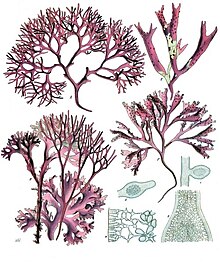
Back طحلب أيرلندي Arabic Chondrus crispus AST Molsa d'Irlanda Catalan Puchratka kadeřavá Czech Knorpeltang German Chondrus crispus Esperanto Chondrus crispus Spanish Chondrus crispus Basque خزه ایرلندی Persian Iirinpunaviuhka Finnish
| Irish moss | |
|---|---|

| |
| A-D Chondrus crispus ; E-F Mastocarpus stellatus | |
| Scientific classification | |
| Clade: | Archaeplastida |
| Division: | Rhodophyta |
| Class: | Florideophyceae |
| Order: | Gigartinales |
| Family: | Gigartinaceae |
| Genus: | Chondrus |
| Species: | C. crispus
|
| Binomial name | |
| Chondrus crispus | |
Chondrus crispus—commonly called Irish moss or carrageenan moss (Irish carraigín, "little rock")—is a species of red algae[1] which grows abundantly along the rocky parts of the Atlantic coasts of Europe and North America. In its fresh condition it is soft and cartilaginous, varying in color from a greenish-yellow, through red, to a dark purple or purplish-brown. The principal constituent is a mucilaginous body, made of the polysaccharide carrageenan, which constitutes 55% of its dry weight. The organism also consists of nearly 10% dry weight protein and about 15% dry weight mineral matter, and is rich in iodine and sulfur. When softened in water it has a sea-like odour. Because of the abundant cell wall polysaccharides, it will form a jelly when boiled, containing from 20 to 100 times its weight of water.
- ^ Wilkes, Robert (13 August 2021), Chondrus crispus (carrageen), doi:10.1079/cabicompendium.89386